We linger in Venice. Not that anyone really needs an excuse, but there is another reason not to rush. I’m here to absorb as much of the city as I can – it’s sights, smells, sounds. The feel of it. It’s what I need to make the swirling thoughts in my head come alive, to create the world of Catarina d’Armano, who will come of age in the Venice of the 1500s, at the apogee of its splendor. Many thanks to La Serenissima. Remove motorized boats and tourists, and there is the city, much as it was then. I have only to repopulate it with men in their distinctive black hats and knee length, wide sleeved black coats (vestas) serving as a background for women clothed in Venice-woven fabrics of elaborate silk brocades and velvets, in colors bright as the palazzos they lived in.
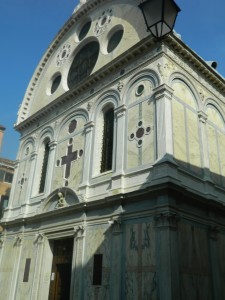 So, here I am, walking the lanes, crossing the bridges, gasping at the vistas, looking
So, here I am, walking the lanes, crossing the bridges, gasping at the vistas, looking 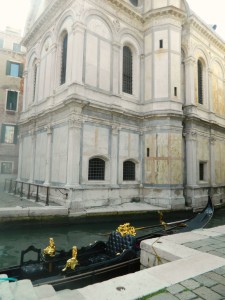 for the perfect palazzo for my heroine. I have decided that she should live close to my favorite of all Venice’s churches – St. Maria dei Miracoli, a jewel box – very small by Venitian standards.
for the perfect palazzo for my heroine. I have decided that she should live close to my favorite of all Venice’s churches – St. Maria dei Miracoli, a jewel box – very small by Venitian standards.
It all began in the summer of 1480, when a painting of the Virgin and child, which hung in a niche a few steps away from the current church, attracted enormous devotion because of recurring events starting with the healing of a woman stabbed by a relative. The family owning the painting proposed that a chapel be built to house it. Money poured in from the faithful (indulgences were granted for contributions) and in 1489, the miraculous picture was moved to its new home.
Clad in veined, pale peach marble panels, set between classic pillars upholding rounded arches, it is further decorated with porphyry lunettes, and the whole thing glows.
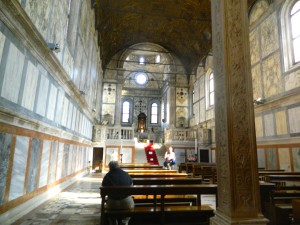 The interior, with the same pale marble, gives the feeling of a fragile egg shell, almost translucent.
The interior, with the same pale marble, gives the feeling of a fragile egg shell, almost translucent.
Above is another one of those marvelous Venitian ceilings, vaulted, with  paintings of patriarchs and prophets set off by elaborate gold leaf. The raised choir sheltered the chorus of St. Clares resident in the nunnery across the way. A dozen steps above the congregation is the altar, crowned by the famous painting. It is perfection.
paintings of patriarchs and prophets set off by elaborate gold leaf. The raised choir sheltered the chorus of St. Clares resident in the nunnery across the way. A dozen steps above the congregation is the altar, crowned by the famous painting. It is perfection.
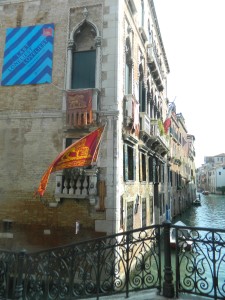 We walk the narrow lanes leading from the Campo, turn a corner, and there it is. Catarina’s palazzo. Situated with canals on two sides, it rises from the water, pale rose, with a marble balustrade flying the banner of Venice – the golden winged lion
We walk the narrow lanes leading from the Campo, turn a corner, and there it is. Catarina’s palazzo. Situated with canals on two sides, it rises from the water, pale rose, with a marble balustrade flying the banner of Venice – the golden winged lion 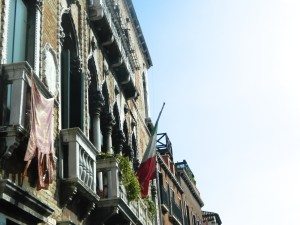 on a scarlet background. Ca’ Pizzani.
on a scarlet background. Ca’ Pizzani.
I have found my inspiration.

Sharon, There WAS a convent of St. Clare sisters in Chicago when Bob was a young priest in charge of the Episcopal Church in the Loop. St. Clares, as you probably know, are enclosed and discalced. It was his good fortune to meet one of the “extern” sisters in the city at a meeting of clergy and religious. She invited him to the house, where she introduced him to the abbess. The two took to each other. They had not one, but any number of meetings at the house over a two-year period before the house closed for financial reasons, and the nuns were scattered to several convents. The abbess told Bob she had the nuns praying for his conversion(!). She sent two extern sisters to Bob’s Eastern Orthodox wedding to his first wife. This was when the ecumenical movement had legs. Thank you for the above delightful preview of your new book!
Jane – Thanks so much for telling me about Bob and the abbess. The Clares convent in Venice was active until 1810. There was a bridge (now demolished) from the second story of the convent directly to the choir loft of St. Maria dei Miracoli so the nuns could enter unobserved. The Clares will play a prominent role in the story. During this period, the majority of young upper-class women became nuns as the size of the dowries required for marriage to a shrinking pool of eligible young men became prohibitive. (Families, wanting to preserve their wealth intact, often allowed only one or two of the sons to marry.) The dowry required for entry into a convent was considerably smaller. The single life was not a possibility.
I left an earlier reply this afternoon, but I lost it when my computer suddenly shut down. Here’s the gist. CORRECTION: The nuns I mentioned above are NOT the St. Clares, In the US anyway they’re the POOR CLARES. I recommend you read Galileo’s Daughter (if you haven’t already). It’s a novel based on her life. It’s well-written and convincing about life in a convent in that era (mid-1500s to mid- 1600s when Galileo lived. Their lives were miserable. They were often hungry as they could do nothing but live on hand-outs unless the convent was adequately endowed (since, as you point out, dowries to convents were modest indeed). She would have starved to death as was common, except that her father sent food from time-to-time. She was apparently brilliant but had no way to exercise her gifts. He lived not far away, but rarely saw her, and he was the only person she had to turn to. By the way, I’d be lost in my studies of ANYTHING if I didn’t have a copy of Brewer’s Dictionary of Phrase and Fable. I hope you have access to it.